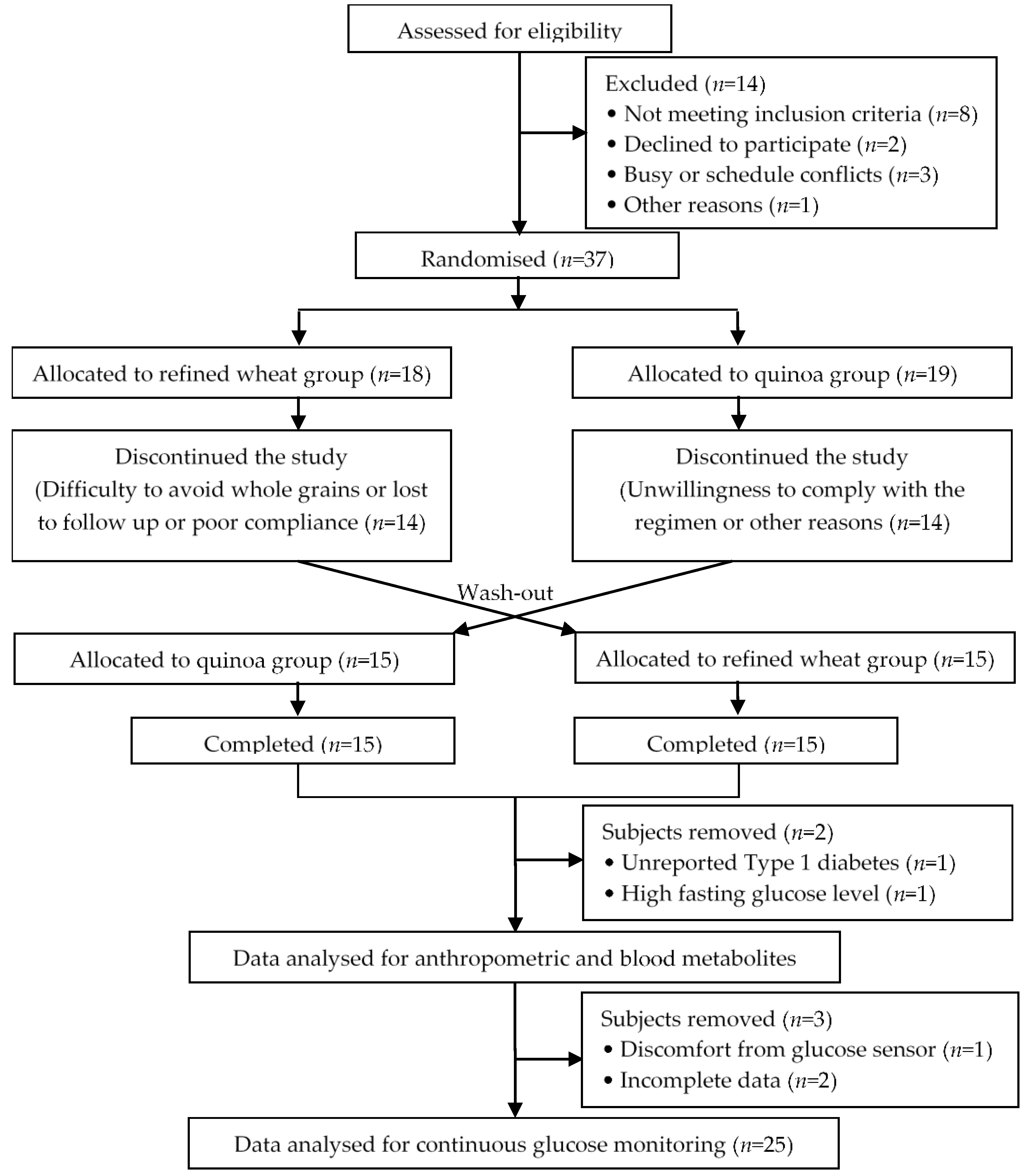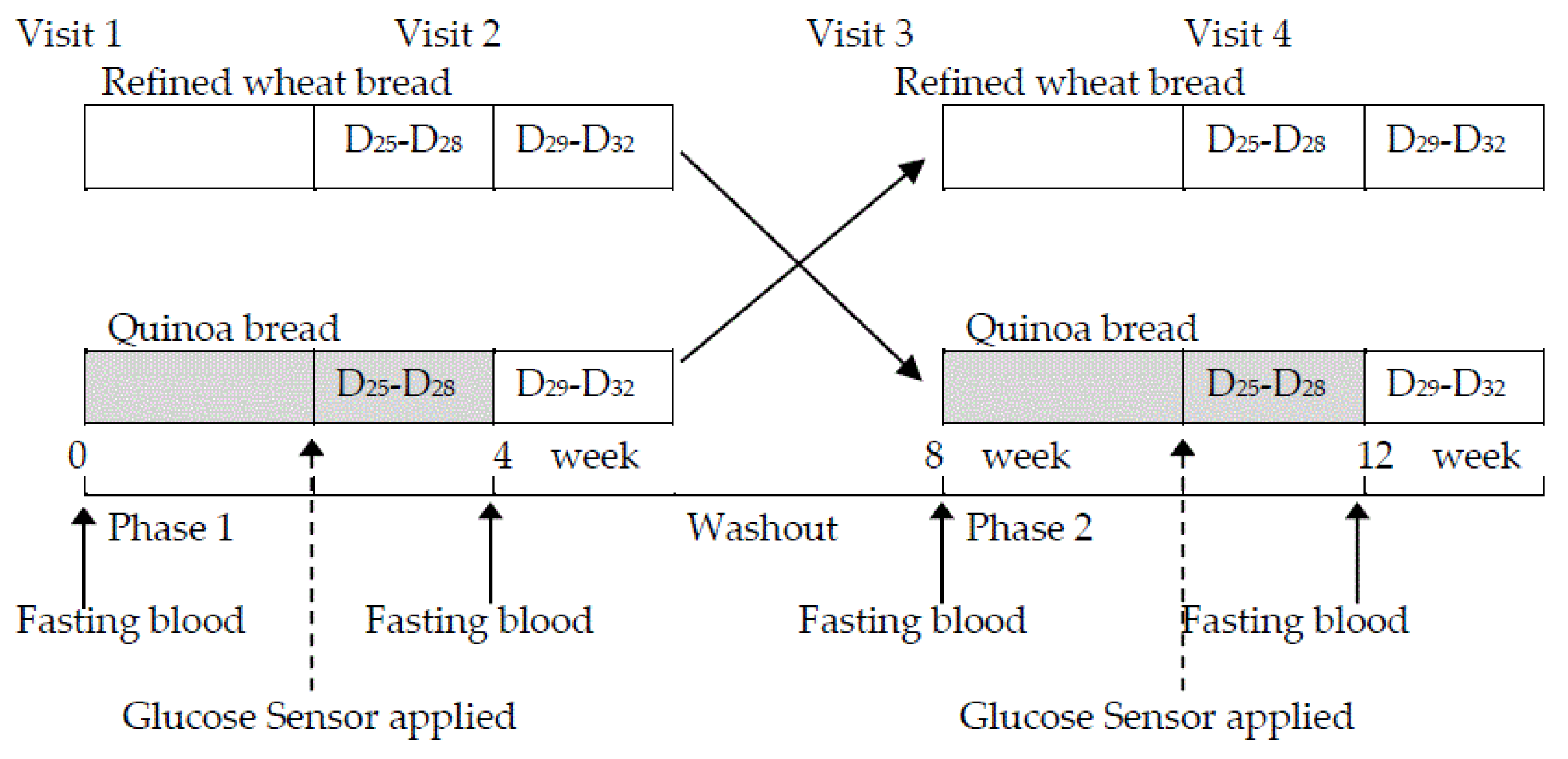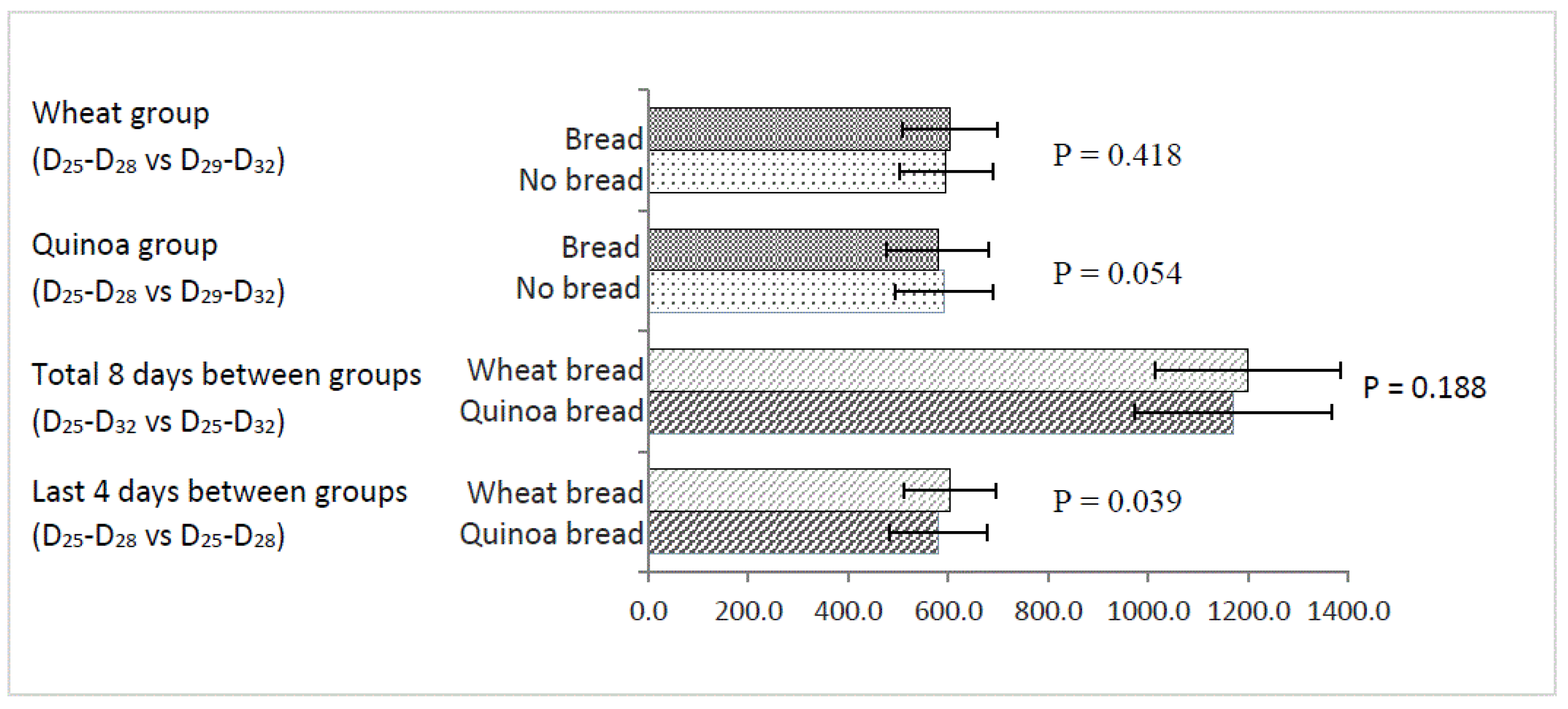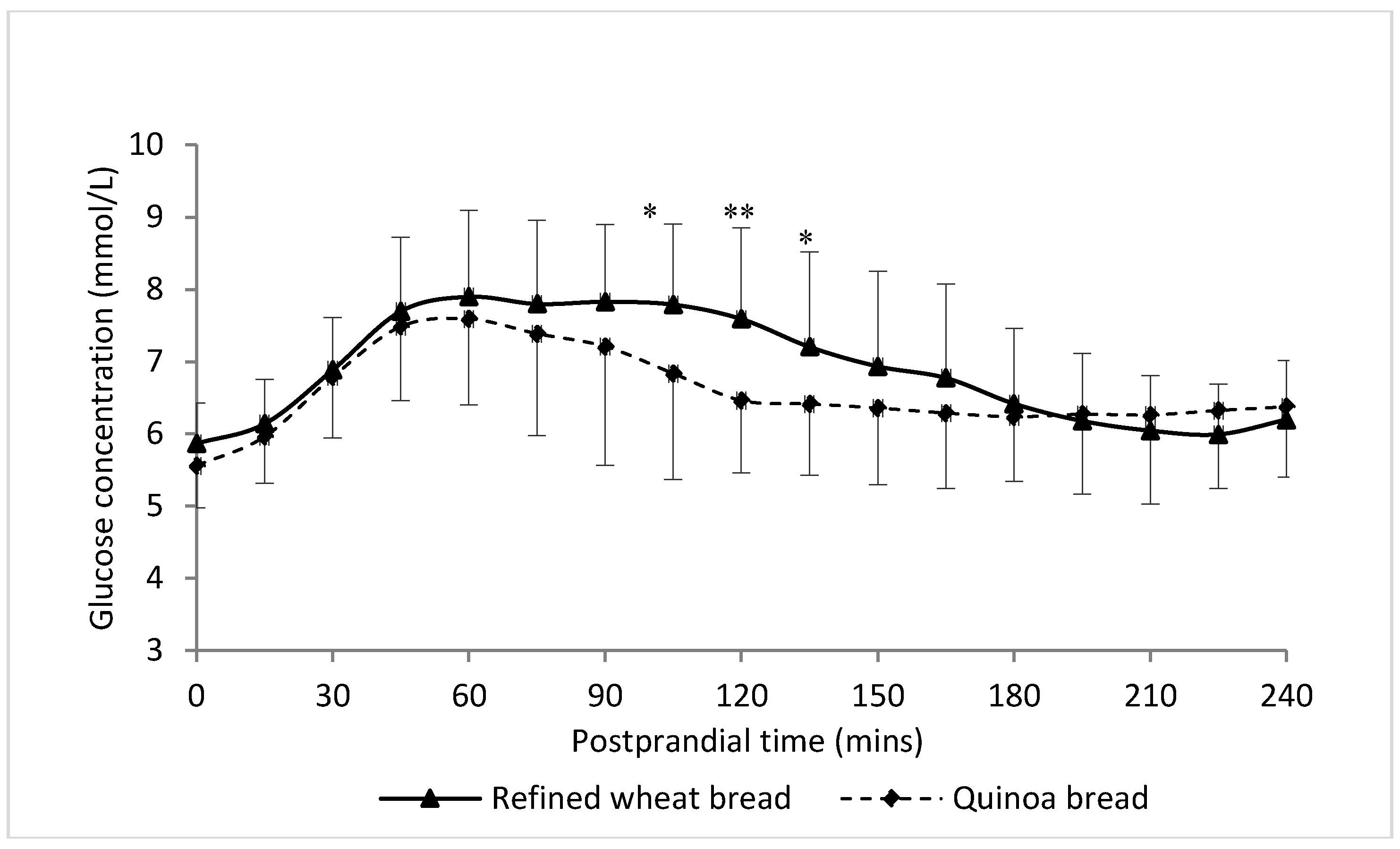Effects of Quinoa (Chenopodium quinoa Willd.) Consumption on Markers of CVD Risk
Abstract
1. Introduction
2. Materials and Methods
2.1. Study Design
2.2. Study Food
2.3. Analytical Methods
2.3.1. Compositional Analysis of Refined Wheat and Quinoa Roll
2.3.2. Plasma and Urine
2.4. Sample Size
2.5. Calculations and Statistical Analyses
3. Results
3.1. Composition of 100% Refined Wheat and 20% Quinoa Bread
3.2. Anthropometric Variables
3.3. Blood Variables and Antioxidant Capacity
3.4. Dietary Intake and Compliance
3.5. Continuous Glucose Monitoring
3.5.1. Area under Curve Glucose Response Curve
3.5.2. Postprandial Glucose
4. Discussion
5. Conclusions
Author Contributions
Funding
Conflicts of Interest
References
- Food and Agriculture Organization (FAO). Food and Nutrition in Numbers 2014; Food and Agriculture Organization: Rome, Italy, 2014; Available online: http://www.fao.org/publications/card/en/c/9f31999d-be2d-4f20-a645-a849dd84a03e/ (accessed on 5 June 2018).
- Van der Kamp, J.W.; Poutanen, K.; Seal, C.J.; Richardson, D.P. The Healthgrain definition of ‘whole grain’. Food Nutr. Res. 2014, 58, 1–8. [Google Scholar] [CrossRef] [PubMed]
- Aune, D.; Norat, T.; Romundstad, P.; Vatten, L.J. Whole grain and refined grain consumption and the risk of type 2 diabetes: A systematic review and dose-response meta-analysis of cohort studies. Eur. J. Epidemiol. 2013, 28, 845–858. [Google Scholar] [CrossRef] [PubMed]
- Aune, D.; Keum, N.; Giovannucci, E.; Fadnes, L.T.; Boffetta, P.; Greenwood, D.C.; Tonstad, S.; Vatten, L.J.; Riboli, E.; Norat, T. Whole grain consumption and risk of cardiovascular disease, cancer, and all cause and cause specific mortality: Systematic review and dose-response meta-analysis of prospective studies. BMJ 2016, 353, i2716. [Google Scholar] [CrossRef] [PubMed]
- Hollaender, P.L.; Ross, A.B.; Kristensen, M. Whole-grain and blood lipid changes in apparently healthy adults: A systematic review and meta-analysis of randomized controlled studies. Am. J. Clin. Nutr. 2015, 102, 556–572. [Google Scholar] [CrossRef] [PubMed]
- McRae, M.P. Health benefits of dietary whole grains: An umbrella review of meta-analyses. J. Chiropr. Med. 2017, 16, 10–18. [Google Scholar] [CrossRef] [PubMed]
- WHO. World Health Statistics 2017: Monitoring Health for the SDGs. Available online: http://www.who.int/gho/publications/world_health_statistics/2017/en/ (accessed on 5 June 2018).
- Ge, K. The transition of Chinese dietary guidelines and the food guide pagoda. Asia Pac. J. Clin. Nutr. 2011, 20, 439–446. [Google Scholar] [PubMed]
- Ando, H.; Chen, Y.C.; Tang, H.J.; Shimizu, M.; Watanabe, K.; Mitsunaga, T. Food components in fractions of quinoa seed. Food Sci. Technol. Res. 2002, 8, 80–84. [Google Scholar] [CrossRef]
- Konishi, Y.; Hirano, S.; Tsuboi, H.; Wada, M. Distribution of minerals in quinoa (Chenopodium quinoa willd.) seeds. Biosci. Biotechnol. Biochem. 2004, 68, 231–234. [Google Scholar] [CrossRef] [PubMed]
- Bhargava, A.; Shukla, S.; Ohri, D. Chenopodium quinoa—An Indian perspective. Ind. Crop. Prod. 2006, 23, 73–87. [Google Scholar] [CrossRef]
- Alvarez-Jubete, L.; Arendt, E.K.; Gallagher, E. Nutritive value and chemical composition of pseudocereals as gluten-free ingredients. Int. J. Food Sci. Nutr. 2009, 60, 240–257. [Google Scholar] [CrossRef] [PubMed]
- Tang, Y.; Li, X.H.; Zhang, B.; Chen, P.X.; Liu, R.H.; Tsao, R. Characterisation of phenolics, betanins and antioxidant activities in seeds of three Chenopodium quinoa willd. Genotypes. Food Chem. 2015, 166, 380–388. [Google Scholar] [CrossRef] [PubMed]
- Jenkins, D.J.A.; Kendall, C.W.C.; McKeown-Eyssen, G.; Josse, R.G.; Silverberg, J.; Booth, G.L.; Vidgen, E.; Josse, A.R.; Nguyen, T.H.; Corrigan, S.; et al. Effect of a low-glycemic index or a high-cereal fiber diet on type 2 diabetes a randomized trial. JAMA 2008, 300, 2742–2753. [Google Scholar] [CrossRef] [PubMed]
- Farinazzi-Machado, F.M.V.; Barbalho, S.M.; Oshiiwa, M.; Goulart, R.; Pessan, O. Use of cereal bars with quinoa (Chenopodium quinoa w) to reduce risk factors related to cardiovascular diseases. Cienc. Tecnol. Aliment. 2012, 32, 239–244. [Google Scholar] [CrossRef]
- De Carvalho, F.G.; Ovidio, P.P.; Padovan, G.J.; Jordao, A.A.; Marchini, J.S.; Navarro, A.M. Metabolic parameters of postmenopausal women after quinoa or corn flakes intake—A prospective and double-blind study. Int. J. Food Sci. Nutr. 2014, 65, 380–385. [Google Scholar] [CrossRef] [PubMed]
- Zevallos, V.F.; Herencia, L.I.; Chang, F.J.; Donnelly, S.; Ellis, H.J.; Ciclitira, P.J. Gastrointestinal effects of eating quinoa (Chenopodium quinoa willd.) in celiac patients. Am. J. Gastroenterol. 2014, 109, 270–278. [Google Scholar] [CrossRef] [PubMed]
- Konishi, Y.; Arai, N.; Umeda, J.; Gunji, N.; Saeki, S.; Takao, T.; Minoguchi, R.; Kensho, G. Cholesterol lowering effect of the methanol insoluble materials from the quinoa seed pericarp. Hydrocolloids (Pt 2) 1999, 417–422. [Google Scholar] [CrossRef]
- Takao, T.; Watanabe, N.; Yuhara, K.; Itoh, S.; Suda, S.; Tsuruoka, Y.; Nakatsugawa, K.; Konishi, Y. Hypocholesterolemic effect of protein isolated from quinoa (Chenopodium quinoa Willd.) seeds. Food Sci. Technol. Res. 2005, 11, 161–167. [Google Scholar] [CrossRef]
- Paśko, P.; Zagrodzki, P.; Bartoń, H.; Chlopicka, J.; Gorinstein, S. Effect of quinoa seeds (Chenopodium quinoa) in diet on some biochemical parameters and essential elements in blood of high fructose-fed rats. Plant Food Hum. Nutr. 2010, 65, 333–338. [Google Scholar] [CrossRef] [PubMed]
- Li, L.; Shewry, P.R.; Ward, J.L. Phenolic acids in wheat varieties in the Healthgrain diversity screen. J. Agric. Food Chem. 2008, 56, 9732–9739. [Google Scholar] [CrossRef] [PubMed]
- Adom, K.K.; Liu, R.H. Antioxidant activity of grains. J. Agric. Food Chem. 2002, 50, 6182–6187. [Google Scholar] [CrossRef] [PubMed]
- Zhang, Q.; Zhang, J.Z.; Shen, J.K.; Silva, A.; Dennis, D.A.; Barrow, C.J. A simple 96-well microplate method for estimation of total polyphenol content in seaweeds. J. Appl. Phycol. 2006, 18, 445–450. [Google Scholar] [CrossRef]
- US Department of Health and Human Services and US Department of Agriculture. 2015–2020 Dietary Guidelines for Americans, 8th ed. Available online: https://health.gov/dietaryguidelines/2015/guidelines/ (accessed on 14 May 2018).
- Australian Government National Health and Medical Research Council. Australian Dietary Guidelines. Available online: https://www.Eatforhealth.Gov.Au/guidelines (accessed on 14 May 2018).
- Seal, C.J.; Brownlee, I.A. Whole-grain foods and chronic disease: Evidence from epidemiological and intervention studies. Proc. Nutr. Soc. 2015, 74, 313–319. [Google Scholar] [CrossRef] [PubMed]
- Harland, J.I.; Garton, L.E. Whole-grain intake as a marker of healthy body weight and adiposity. Public Health Nutr. 2008, 11, 554–563. [Google Scholar] [CrossRef] [PubMed]
- Kristensen, M.; Toubro, S.; Jensen, M.G.; Ross, A.B.; Riboldi, G.; Petronio, M.; Bügel, S.; Tetens, I.; Astrup, A. Whole grain compared with refined wheat decreases the percentage of body fat following a 12-week, energy-restricted dietary intervention in postmenopausal women. J. Nutr. 2012, 142, 710–716. [Google Scholar] [CrossRef] [PubMed]
- Suhr, J.; Vuholm, S.; Iversen, K.N.; Landberg, R.; Kristensen, M. Wholegrain rye, but not wholegrain wheat, lowers body weight and fat mass compared with refined wheat: A 6-week randomized study. Eur. J. Clin. Nutr. 2017, 71, 959. [Google Scholar] [CrossRef] [PubMed]
- Martín-Timón, I.; Sevillano-Collantes, C.; Segura-Galindo, A.; del Cañizo-Gómez, F.J. Type 2 diabetes and cardiovascular disease: Have all risk factors the same strength? World J. Diabetes 2014, 5, 444–470. [Google Scholar] [CrossRef] [PubMed]
- Gabrial, S.G.; Shakib, M.R.; Gabrial, G.N. Effect of pseudocereal-based breakfast meals on the first and second meal glucose tolerance in healthy and diabetic subjects. Maced. J. Med. Sci. 2016, 4, 565–573. [Google Scholar] [CrossRef] [PubMed]
- Hanamura, T.; Mayama, C.; Aoki, H.; Hirayama, Y.; Shimizu, M. Antihyperglycemic effect of polyphenols from acerola (Malpighia emarginata dc.) fruit. Biosci. Biotechnol. Biochem. 2006, 70, 1813–1820. [Google Scholar] [CrossRef] [PubMed]
- Kobayashi, Y.; Suzuki, M.; Satsu, H.; Arai, S.; Hara, Y.; Suzuki, K.; Miyamoto, Y.; Shimizu, M. Green tea polyphenols inhibit the sodium-dependent glucose transporter of intestinal epithelial cells by a competitive mechanism. J. Agric. Food Chem. 2000, 48, 5618–5623. [Google Scholar] [CrossRef] [PubMed]
- Torronen, R.; Sarkkinen, E.; Tapola, N.; Hautaniemi, E.; Kilpi, K.; Niskanen, L. Berries modify the postprandial plasma glucose response to sucrose in healthy subjects. Br. J. Nutr. 2010, 103, 1094–1097. [Google Scholar] [PubMed]
- Nyambe-Silavwe, H.; Williamson, G. Polyphenol- and fibre-rich dried fruits with green tea attenuate starch-derived postprandial blood glucose and insulin: A randomised, controlled, single-blind, cross-over intervention. Br. J. Nutr. 2016, 116, 443–450. [Google Scholar] [CrossRef] [PubMed]
- Johnston, K.L.; Clifford, M.N.; Morgan, L.M. Possible role for apple juice phenolic, compounds in the acute modification of glucose tolerance and gastrointestinal hormone secretion in humans. J. Sci. Food Agric. 2002, 82, 1800–1805. [Google Scholar] [CrossRef]
- Johnston, K.L.; Clifford, M.N.; Morgan, L.M. Coffee acutely modifies gastrointestinal hormone secretion and glucose tolerance in humans: Glycemic effects of chlorogenic acid and caffeine. Am. J. Clin. Nutr. 2003, 78, 728–733. [Google Scholar] [CrossRef] [PubMed]
- Jenkins, D.J.A.; Wolever, T.M.S.; Leeds, A.R.; Gassull, M.A.; Haisman, P.; Dilawari, J.; Goff, D.V.; Metz, G.L.; Alberti, K.G.M.M. Dietary fibers, fiber analogs, and glucose-tolerance—importance of viscosity. BMJ 1978, 1, 1392–1394. [Google Scholar] [CrossRef] [PubMed]
- Lewis, S.J.; Heaton, K.W. Increasing butyrate concentration in the distal colon by accelerating intestinal transit. Gut 1997, 41, 245–251. [Google Scholar] [CrossRef] [PubMed]
- Hejazi, M.A. Preparation of different formulae from quinoa and different sources dietary fiber to treat obesity in rats. Nat. Sci. 2016, 14, 55–65. [Google Scholar]
- Li, B.; Zhang, G.; Tan, M.; Zhao, L.; Jin, L.; Tang, X.; Jiang, G.; Zhong, K. Consumption of whole grains in relation to mortality from all causes, cardiovascular disease, and diabetes: Dose-response meta-analysis of prospective cohort studies. Medicine 2016, 95, e4229. [Google Scholar] [CrossRef] [PubMed]
- Mann, K.D.; Pearce, M.S.; Seal, C.J. Providing evidence to support the development of whole grain dietary recommendations in the United Kingdom. Proc. Nutr. Soc. 2017, 76, 369–377. [Google Scholar] [CrossRef] [PubMed]
- Theuwissen, E.; Mensink, R.P. Water-soluble dietary fibers and cardiovascular disease. Physiol. Behav. 2008, 94, 285–292. [Google Scholar] [CrossRef] [PubMed]
- Ho, H.; Jovanovski, E.; Zurbau, A.; Mejia, S.B.; Sievenpiper, J.; Au-Yeung, F.; Jenkins, A.L.; Duvnjak, L.; Leiter, L.; Vuksan, V. A systematic review and meta-analysis of randomized controlled trials of the effect of konjac glucomannan, a viscous soluble fiber, on LDL cholesterol and the new lipid targets non-HDL cholesterol and apolipoprotein b. Am. J. Clin. Nutr. 2017, 105, 1239–1247. [Google Scholar] [CrossRef] [PubMed]
- Davinelli, S.; Corbi, G.; Righetti, S.; Sears, B.; Olarte, H.H.; Grassi, D.; Scapagnini, G. Cardioprotection by cocoa polyphenols and omega-3 fatty acids: A disease-prevention perspective on aging-associated cardiovascular risk. J. Med. Food 2018. ahead of print. [Google Scholar] [CrossRef] [PubMed]
- Davinelli, S.; Scapagnini, G. Polyphenols: A promising nutritional approach to prevent or reduce the progression of prehypertension. High Blood Press. Cardiovasc. Prev. 2016, 23, 197–202. [Google Scholar] [CrossRef] [PubMed]




| Nutrient | 100% Refined Wheat Bread | 20% Quinoa Bread |
|---|---|---|
| Energy (kcal/100 g) | 381 | 381 |
| (kJ/100 g) | 1615 | 1612 |
| Protein (g/100 g) | 12.63 | 14.04 |
| Ash (g/100 g) | 2.37 | 2.87 |
| Moisture (g/100 g) | 2.69 | 3.02 |
| Available Carbohydrate (g/100 g) | 77.05 | 72.64 |
| Total sugars (g/100 g) | 6.67 | 5.78 |
| Sodium (g/100 g) | 0.51 | 0.62 |
| Salt (g/100 g) | 1.30 | 1.58 |
| Insoluble dietary fibre (g/100 g) | 2.17 | 4.99 |
| Soluble dietary fibre (g/100 g) | 1.43 | 1.53 |
| Total dietary fibre (g/100 g) | 3.60 | 6.52 |
| Fat (g/100 g) | 1.66 | 2.73 |
| Saturated fat (g/100 g) | 0.29 | 0.37 |
| Monounsaturated fat (g/100 g) | 0.24 | 0.68 |
| Polyunsaturated fat (g/100 g) | 1.06 | 1.56 |
| Total phenolic content (mg GAE/g) 2 | ||
| Free | 0.52 ± 0.04 | 0.76 ± 0.06 |
| Conjugated | 0.08 ± 0.01 | 0.16 ± 0.01 |
| Bound | 0.08 ± 0.01 | 0.19 ± 0.02 |
| Total | 0.77 | 1.11 |
| Amino acid | 100% Refined Wheat Bread | 20% Quinoa Bread |
|---|---|---|
| Essential amino acids | ||
| Histidine (g/100 g) | 0.28 | 0.35 |
| Iso-Leucine (g/100 g) | 0.49 | 0.46 |
| Leucine (g/100 g) | 0.90 | 0.78 |
| Lysine (g/100 g) | 0.32 | 0.81 |
| Methionine (g/100 g) | 0.18 | 0.27 |
| Phenylalanine (g/100 g) | 0.66 | 0.48 |
| Threonine (g/100 g) | 0.38 | 0.50 |
| Valine (g/100 g) | 0.59 | 0.59 |
| Non-essential amino acids | ||
| Alanine (g/100 g) | 0.41 | 0.58 |
| Arginine (g/100 g) | 0.53 | 1.07 |
| Aspartic Acid (g/100 g) | 0.56 | 1.07 |
| Cystine (g/100 g) | 0.29 | 0.20 |
| Glutamic Acid (g/100 g) | 4.55 | 1.70 |
| Glycine (g/100 g) | 0.49 | 0.68 |
| Proline (g/100 g) | 1.56 | 0.49 |
| Serine (g/100 g) | 0.74 | 0.62 |
| Tyrosine (g/100 g) | 0.39 | 0.39 |
| Outcome | Refined Wheat Bread (n = 28) | Quinoa Bread (n = 28) | |||||||||
|---|---|---|---|---|---|---|---|---|---|---|---|
| Baseline | Week 4 | Baseline | Week 4 | p for | |||||||
| Mean | SD | Mean | SD | Δ% 2 | Mean | SD | Mean | SD | Δ% | Change 3 | |
| Anthropometric variables 1 | |||||||||||
| Age | 51.5 | 10.7 | - | - | - | - | - | - | - | - | - |
| Body weight (kg) | 85.8 | 9.5 | 86.0 | 9.3 | 0.2 | 85.9 | 9.6 | 85.8 | 9.5 | −0.1 | 0.279 |
| BMI (kg/m2) | 27.6 | 2.3 | 27.7 | 2.3 | 0.3 | 27.7 | 2.4 | 27.6 | 2.4 | −0.4 | 0.281 |
| Body fat percentage (%) | 25.4 | 5.2 | 25.7 | 5.0 | 1.2 | 25.4 | 5.2 | 25.2 | 5.0 | −0.8 | 0.331 |
| Blood pressure (mmHg) | |||||||||||
| Systolic | 129.5 | 12.2 | 130.5 | 12.2 | 0.8 | 128.8 | 12.6 | 128.5 | 11.0 | −0.2 | 0.272 |
| Diastolic | 85.4 | 10.2 | 86.4 | 14.5 | 1.2 | 84.1 | 9.7 | 85.8 | 10.1 | 2.0 | 0.726 |
| Blood variables | |||||||||||
| Glucose (mmol/L) | 5.71 | 0.56 | 5.64 | 0.53 | −1.2 | 5.84 | 0.63 | 5.58 | 0.68 | −4.5 ** | 0.103 |
| Insulin (pmol/L) | 54.9 | 21.09 | 58.4 | 26.67 | 6.5 | 54.1 | 25.4 | 61.5 | 32.32 | 13.7 | 0.278 |
| Cholesterol (mmol/L) | |||||||||||
| Total | 5.63 | 1.20 | 5.50 | 0.99 | −2.3 | 5.64 | 1.04 | 5.54 | 0.78 | −1.8 | 0.769 |
| LDL | 3.53 | 0.93 | 3.36 | 0.76 | −4.8 | 3.49 | 0.84 | 3.29 | 0.65 | −5.7 * | 0.439 |
| HDL | 1.36 | 0.25 | 1.38 | 0.23 | 2.0 | 1.39 | 0.22 | 1.39 | 0.22 | 0.2 | 0.363 |
| Triglyceride (mmol/L) | 1.41 | 0.59 | 1.53 | 0.59 | 8.9 | 1.39 | 0.52 | 1.59 | 0.57 | 14.3 * | 0.587 |
| NEFAs (mmol/L) | 0.39 | 0.17 | 0.36 | 0.14 | −9.9 | 0.42 | 0.17 | 0.35 | 0.15 | −16.2 | 0.496 |
| Apo (g/L) | |||||||||||
| ApoA1 | 1.38 | 0.19 | 1.38 | 0.18 | 0.0 | 1.41 | 0.18 | 1.39 | 0.16 | −1.5 | 0.415 |
| ApoB | 1.16 | 0.25 | 1.12 | 0.20 | −3.3 | 1.15 | 0.21 | 1.12 | 0.16 | −2.1 | 0.798 |
| Ratios | |||||||||||
| HDL/Total | 0.25 | 0.08 | 0.26 | 0.05 | 7.0 | 0.25 | 0.06 | 0.26 | 0.05 | 3.2 | 0.295 |
| ApoB/ApoA1 | 1.25 | 0.36 | 1.27 | 0.27 | 3.5 | 1.26 | 0.26 | 1.26 | 0.26 | 0.4 | 0.203 |
| CRP (mg/L) | 1.69 | 0.71 | 2.21 | 0.69 | 30.8 | 1.72 | 0.41 | 1.43 | 0.28 | 16.9 | 0.197 |
| AST (U/L) | 41.1 | 17.79 | 40.2 | 16.55 | −2.1 | 47.2 | 47.4 | 42.8 | 27.97 | −9.3 | 0.526 |
| ALT (U/L) | 34.5 | 26.80 | 35.7 | 26.39 | 3.4 | 60.4 | 46.8 | 39.3 | 38.61 | −34.9 | 0.277 |
| Nutrient | Refined Wheat Bread (n = 28) | Quinoa Bread (n = 28) | |||||
|---|---|---|---|---|---|---|---|
| Baseline | Week 4 | Δ% 1 | Baseline | Week 4 | Δ% | p for Change 2 | |
| Energy (kJ) | 9505 ± 1320 | 10,065 ± 1275 | 5.9 | 9600 ± 1630 | 9956 ± 1685 | 3.7 | 0.733 |
| Carbohydrates | |||||||
| (g/day) | 241 ± 50 | 285 ± 46 | 18.3 * | 250 ± 60 | 270 ± 43.1 | 8.0 | 0.623 |
| (%E) | 50.2 ± 6.1 | 53.1 ± 5.0 | 5.8 | 49.5 ± 7.9 | 52.2 ± 5.5 | 5.5 | 0.799 |
| Protein | |||||||
| (g/day) | 79.2 ± 16.1 | 87.5 ± 20.3 | 10.5 | 81.5 ± 16.9 | 90.4 ± 17.4 | 10.9 | 0.347 |
| (%E) | 17.0 ± 2.2 | 15.8 ± 2.4 | −7.1 | 15.7 ± 2.2 | 16.9 ± 3.5 | 7.6 | 0.414 |
| Fat | |||||||
| (g/day) | 64.2 ± 13.1 | 71.0 ± 18.4 | 10.6 | 76.5 ± 20.1 | 72.2 ± 19.8 | −5.6 | 0.424 |
| (%E) | 29.8 ± 5.2 | 28.5 ± 4.5 | −4.4 | 32.6 ± 5.0 | 28.9 ± 4.2 | −11.3 | 0.396 |
| SFA | |||||||
| (g/day) | 27.5 ± 5.4 | 29.3 ± 7.9 | 6.5 | 32.8 ± 8.9 | 30.7 ± 9.4 | −6.4 | 0.198 |
| (%E) | 12.8 ± 2.2 | 12.0 ± 1.9 | −6.3 | 13.9 ± 2.7 | 12.6 ± 2.2 | −9.4 | 0.465 |
| MUFA | |||||||
| (g/day) | 23.4 ± 5.8 | 25.7 ± 6.6 | 9.8 | 27.5 ± 6.8 | 25.0 ±7.6 | −9.1 | 0.785 |
| (%E) | 10.9 ± 2.0 | 10.2 ± 1.5 | −6.4 | 11.6 ± 2.1 | 10.2 ± 1.4 | −12.1 | 0.743 |
| PUFA | |||||||
| (g/day) | 9.3 ± 2.5 | 10.7 ± 2.4 | 15.1 | 10.3 ± 2.8 | 10.3 ± 2.4 | 0 | 0.854 |
| (%E) | 4.5 ± 0.8 | 4.4 ± 1.0 | 2.2 | 4.8 ± 0.7 | 4.3 ± 1.0 | −10.4 | 0.782 |
| Alcohol | |||||||
| (g/day) | 5.3 ± 2.3 | 6.6 ± 4.0 | 24.5 | 4.5 ± 1.9 | 5.2 ± 2.8 | 15.5 | 0.587 |
| (%E) | 1.8 ± 0.8 | 2.2 ± 1.3 | 22.2 | 1.5 ± 0.7 | 1.5 ± 0.9 | 0 | 0.154 |
| Dietary fibre (g/day) | 22.1 ± 5.6 | 20.1 ± 6.4 | −9.0 | 24.7 ± 6.9 | 22.5 ± 4.8 | −8.9 | 0.687 |
© 2018 by the authors. Licensee MDPI, Basel, Switzerland. This article is an open access article distributed under the terms and conditions of the Creative Commons Attribution (CC BY) license (http://creativecommons.org/licenses/by/4.0/).
Share and Cite
Li, L.; Lietz, G.; Bal, W.; Watson, A.; Morfey, B.; Seal, C. Effects of Quinoa (Chenopodium quinoa Willd.) Consumption on Markers of CVD Risk. Nutrients 2018, 10, 777. https://doi.org/10.3390/nu10060777
Li L, Lietz G, Bal W, Watson A, Morfey B, Seal C. Effects of Quinoa (Chenopodium quinoa Willd.) Consumption on Markers of CVD Risk. Nutrients. 2018; 10(6):777. https://doi.org/10.3390/nu10060777
Chicago/Turabian StyleLi, Liangkui, Georg Lietz, Wendy Bal, Anthony Watson, Ben Morfey, and Chris Seal. 2018. "Effects of Quinoa (Chenopodium quinoa Willd.) Consumption on Markers of CVD Risk" Nutrients 10, no. 6: 777. https://doi.org/10.3390/nu10060777
APA StyleLi, L., Lietz, G., Bal, W., Watson, A., Morfey, B., & Seal, C. (2018). Effects of Quinoa (Chenopodium quinoa Willd.) Consumption on Markers of CVD Risk. Nutrients, 10(6), 777. https://doi.org/10.3390/nu10060777





